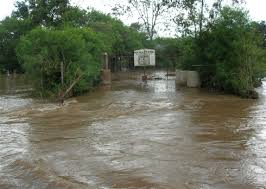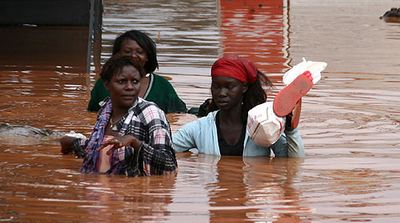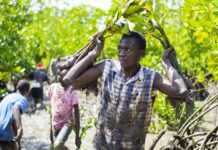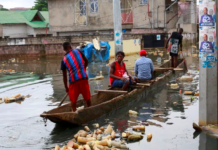By Mary Mwendwa.
The on going damage caused by El -Nino rains which have led to loss of lives and property may not be attributed to climate change, weather expert warns. According to Peter Ambenje, Deputy Director,Kenya Meteorological Department; ” To a common person in Kenya, an El-Nino would mean, heavy rainfall events in the October to December rainfall season and the associated impacts such as flooding, mudslides and landslides, destruction of property and infrastructure, disruption of normal activities, loss of lives in some incidences, upsurge of certain diseases such as malaria, cholera and typhoid among others. “
However , Peter Ambenje says there is an advantage to the heavy rains apart from the floods.
The positive side of it is water dams filling up, pasture regenerating, sufficient water for hydro-electric power generation, plenty of rain water to harvest, good performance of crops in various parts such as the southeastern lowlands among others.
Before the heavy rains started across the country, Kenya Meteorological Department .Issued alerts on preparedness, which they used indicators in predicting the weather. Ambeje explains how they use the indicators;

“The Kenya Meteorological Department has models that it runs to generate “Long Range” forecasts (one month to three months ahead). These models have been tested using historical data of observed rainfall and its predictors (scientific indicators) that include Sea Surface Temperature patterns over the Ocean Basins, and winds in the upper levels of the atmosphere among others. These models are run at least one month before the start of the seasonal rains such as the “Short Rains” season. This year, the models were run in the last half of August 2015. The model outputs indicated potential for enhanced rainfall during the “Short Rains” season that lasts from October to December. These results were officially released the forecast for the 2015 “Short Rains” season on 1st September 2015.”
Mr.Ambenje explains further on El-Nino ,” La-Nina would mean relatively low rainfall in the same period and attendant problems such as poor crop performance, limited availability of water for both domestic and industrial use, poor pasture conditions, deterioration in the health of livestock leading to losses, less water inflow into dams for hydro-electric power generation that may lead to power rationing, among others. “
At times there are confusions about what La-Nina and El- Nino would mean to an ordinary person. He says people interpreted differently. “It is not very easy to spell out what El-Nino and La-Nina would mean to a common person. However, both El-Nino and the opposite called La-Nina are Spanish words that are used to refer to the Sea Surface Temperature patterns in the equatorial eastern and central Pacific Ocean. La-Nina occurs when the Sea Surface Temperature anomalies over equatorial eastern and central Pacific Ocean are warmer than usual. The opposite phase when the Sea surface Temperature anomalies are colder than usual is the La-Nina.
Mercy Muthoni,a middle aged woman who has been living in Zimmerman Estate in Nairobi says that every time Nairobi experiences heavy rains her house floods.”It is very normal for our area to flood when it rains. Infact when we heard about El- Nino alerts we got very worried. Nothing much has been done by the County government to clear drainage here.”
Asked whether she knows El-Nino and La –Nina she says she only knows El – Nino is about flooding , La –Nina is another scientific term which she has no idea of .
Mr.Ambenje says that Despite these patterns being very far from us, they tend to influence the climate patterns in Kenya. The tendency, though not one-to-one, is that when an El-Nino occurs, the “Short Rains” in Kenya tend to be enhanced. The reverse is that when a La-Nina occurs, the “Short Rains” tend to be depressed. The overall rainfall patterns are however, also influenced by other factors. For example areas like Budalang’I in Busia County,is prone to flooding that occurs due to heavy rains that pound the upper catchment areas of Mt. Elgon, Cherenganyi Hills. Water overflows or breaks (if there are not strengthened dykes) and cause flooding. Also low lying areas that get flooded when rivers such as Nyando break their banks following heavy rains in the Nandi Hills and other high ground areas in the vicinity.
Ambenje advises People to be alert during heavy rains in various parts of the country for various reasons. “ Vulnerability depends on the exposure to the events , Hilly areas that have been deforested and made settlements are hot spots for landslides, seasonal rivers areas in the upper catchments regions and very strong water currents flowing downstream with the capability of sweeping away anything .Western Kenya areas, Kisii, Kakamega, Bungoma, Vihiga, Busia among other counties do experience heavy rainfall that comes from deep clouds with thunderstorms and lighting. This exposes the communities to dangers of being struck by lightning if they do not take the necessary precautions. Finally urban areas are at risk too because Flash floods do occur in urban areas due to tarmac allover inhibiting water percolation to the soil and leading to mainly surface runoff. If drainage systems are poor, flash floods are the consequence.”He warns.














